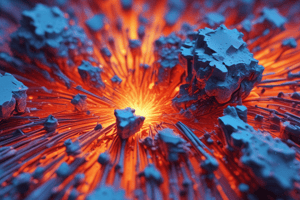Podcast
Questions and Answers
Which of the following materials is considered highly reactive and should be used in optimum dosages for economy and durability?
Which of the following materials is considered highly reactive and should be used in optimum dosages for economy and durability?
- Admixtures
- Cement (correct)
- Fine Aggregates
- Water
What type of water is recommended for use in concrete mixing?
What type of water is recommended for use in concrete mixing?
- Distilled water
- Potable water (correct)
- Recycled water
- Saltwater
Admixtures can be defined as:
Admixtures can be defined as:
- Materials added in large quantities to enhance strength
- Natural or artificial substances added in small amounts to modify properties (correct)
- Common ingredients used in all concrete mixtures
- Waste products from construction processes
Which ancient civilization is noted for using cement in different forms, demonstrating its durability?
Which ancient civilization is noted for using cement in different forms, demonstrating its durability?
What is the significance of finite aggregates and coarse aggregates in the context of construction resources?
What is the significance of finite aggregates and coarse aggregates in the context of construction resources?
Which compound is primarily responsible for the early strength in cement?
Which compound is primarily responsible for the early strength in cement?
Which of the following compounds does not contribute to strength gain in cement?
Which of the following compounds does not contribute to strength gain in cement?
What is the relationship between C2S and cement strength?
What is the relationship between C2S and cement strength?
Which of the following oxides is associated with the compound C3A?
Which of the following oxides is associated with the compound C3A?
What is the nature of the reaction that occurs during the hydration of cement?
What is the nature of the reaction that occurs during the hydration of cement?
What is the maximum allowable water content for complete hydration in High Strength Concrete?
What is the maximum allowable water content for complete hydration in High Strength Concrete?
What is the effect of lower water content in High Strength Concrete?
What is the effect of lower water content in High Strength Concrete?
Which of the following is NOT a parameter tested for cement quality in the field?
Which of the following is NOT a parameter tested for cement quality in the field?
What should the texture of cement feel like as part of the quality testing?
What should the texture of cement feel like as part of the quality testing?
Which cement grade specification is currently available for Ordinary Portland Cement?
Which cement grade specification is currently available for Ordinary Portland Cement?
What is a sign of early deterioration in High Strength Concrete?
What is a sign of early deterioration in High Strength Concrete?
Which of the following elements is NOT part of the testing process for cement?
Which of the following elements is NOT part of the testing process for cement?
What indicates that cement should float before sinking during quality testing?
What indicates that cement should float before sinking during quality testing?
What are the primary raw materials used in the manufacture of cement?
What are the primary raw materials used in the manufacture of cement?
At what temperature is the raw meal subjected during the calcining process?
At what temperature is the raw meal subjected during the calcining process?
What role does gypsum play in the setting of cement?
What role does gypsum play in the setting of cement?
Which process involves preheating the raw meal before it is subjected to heat in the rotary kiln?
Which process involves preheating the raw meal before it is subjected to heat in the rotary kiln?
How is the quality of cement primarily determined?
How is the quality of cement primarily determined?
Who patented Ordinary Portland Cement (OPC)?
Who patented Ordinary Portland Cement (OPC)?
In which year did India manufacture its first cement?
In which year did India manufacture its first cement?
What is the mixture of crushed and pulverized calcareous and argillaceous materials called before it is fired in the kiln?
What is the mixture of crushed and pulverized calcareous and argillaceous materials called before it is fired in the kiln?
What is the main responsible factor for the early strength of concrete?
What is the main responsible factor for the early strength of concrete?
Which calcium compound is produced in higher quantities during the hydration of C3S?
Which calcium compound is produced in higher quantities during the hydration of C3S?
Why is Ca(OH)2 considered undesirable in cement hydration?
Why is Ca(OH)2 considered undesirable in cement hydration?
Which type of cement is characterized by more C3S and less C2S, making it less durable?
Which type of cement is characterized by more C3S and less C2S, making it less durable?
During the hydration of C2S, what is produced in comparison to C3S hydration?
During the hydration of C2S, what is produced in comparison to C3S hydration?
What negative reaction does Ca(OH)2 have in the presence of sulphates?
What negative reaction does Ca(OH)2 have in the presence of sulphates?
What characterizes the gel produced from C3S compared to that from C2S?
What characterizes the gel produced from C3S compared to that from C2S?
What does the equation 2C2S + 4H → C3S2H3 + Ca(OH)2 signify?
What does the equation 2C2S + 4H → C3S2H3 + Ca(OH)2 signify?
Flashcards are hidden until you start studying
Study Notes
Hydration and Properties of High Strength Concrete (HSC)
- Complete hydration of concrete is not achievable with less than 38% water content.
- Water content exceeding 38% leads to less dense gel formation, increasing permeability and susceptibility to deterioration.
- Optimal lower water content results in denser gel, enhancing impermeability and durability; unhydrated cement particles can hydrate later, further improving structural integrity.
Cement Storage and Transportation
- Cement is transported in bulkers and mixed in transit mixers for concrete application.
- Silos are used for storage at ready-mix concrete plants; adherence to IS 4082:1996 standards is crucial for stacking and storage.
Testing and Quality Control of Cement
- Cement should be less than 90 days old to ensure quality; checks include:
- No lumps present (Lumps Test).
- Uniform color (Color Test).
- Smooth texture when rubbed (Rubbing Test).
- Absence of earthy smell (Smell Test).
- Cool temperature when in hand (Temperature Test).
- Initial floating before sinking (Float Test).
Ordinary Portland Cement Specifications
- Current specifications include IS 269 - 2015 while earlier specifications for grades (33, 43, 53) have been withdrawn.
- Performance improvers and chemical requirements detailed in IS 269 - 2015.
Laboratory Testing of Cement
- Assessments include:
- Standard consistency.
- Initial and final setting time.
- Specific gravity.
- Compressive strength.
- Fineness.
- Soundness.
Cement Composition and Manufacturing
- Cement comprises calcareous (limestone, chalk) and argillaceous (shale, clay) materials, along with gypsum.
- Manufacturing involves crushing and mixing raw materials, followed by heating in a rotary kiln at 1300-1500°C, producing clinkers.
- Clinkers are ground with gypsum to prevent flash setting, influencing die hydration.
Bogue's Compounds
- Four primary compounds influence cement characteristics:
- C3S (Tricalcium Silicate): Contributes to early strength.
- C2S (Dicalcium Silicate): Responsible for delayed strength.
- C3A (Tricalcium Aluminate): Affects early hydration and flash setting.
- C4AF (Tetracalcium Aluminoferrite): Minor influence on strength.
Hydration of Cement
- Hydration is exothermic; compounds hydrate at varying rates.
- C3S contributes to immediate strength and heat generation; C2S supports long-term durability.
- Excess calcium hydroxide (Ca(OH)2) from C3S is undesirable as it fosters leaching and deterioration.
Durability Concerns with High-Grade Cement
- High-grade OPC, containing more C3S than C2S, may lead to lesser quality C-S-H gel and higher Ca(OH)2 levels, compromising durability.
- Ca(OH)2 can react with sulfates, leading to detrimental expansion and cracking in cement structures.
Historical Context
- Historical use of cement by Romans, Greeks, and Egyptians highlights its durability.
- Development of artificial cement by L.J. Vicat and patenting of Ordinary Portland Cement (OPC) by Joseph Aspdin marked significant advancements in cement technology.
Practical Applications
- Notable historical structures like the Pantheon, Temple of Saturn, and the Great Wall of China demonstrate the structural capabilities of concrete through ages.
- Modern applications include bridges, airport runways, and major infrastructure like the Millau Viaduct in France.
Studying That Suits You
Use AI to generate personalized quizzes and flashcards to suit your learning preferences.




